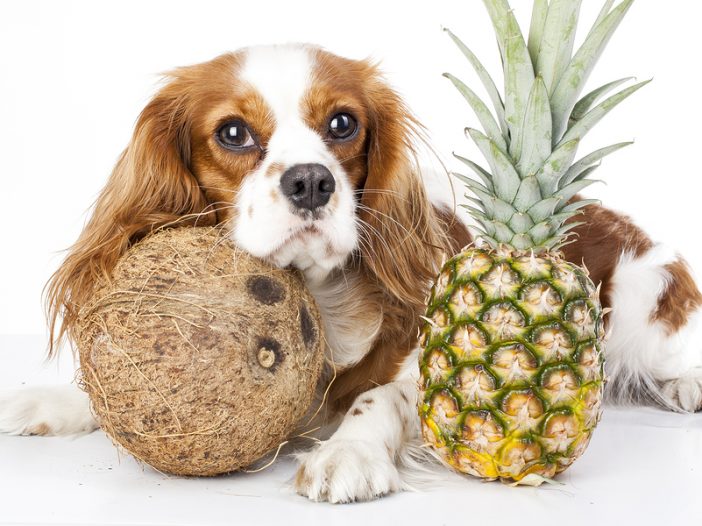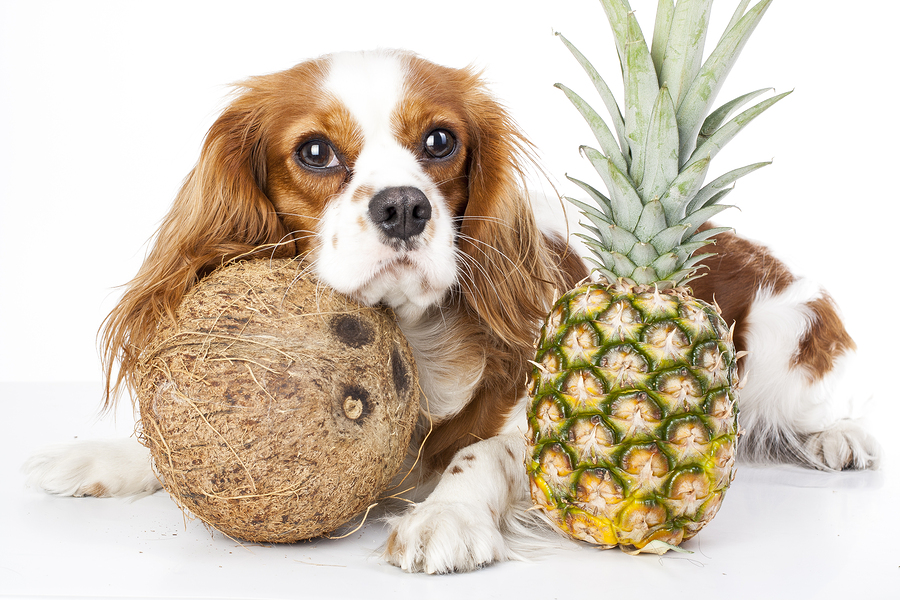
Without a doubt, people’s abundant love for coconut oil has made its way into the pet nutrition realm. People go Coco-Nuts for coconut oil! So why am I not going Coco-Nuts? Let me tell you.

Let’s look at the nutrient profile of coconut oil and focus in on essential fatty acids for dogs and cats. These essential (or required) fatty acids are all polyunsaturated fatty acids (aka PUFAs, if you want use the cool kid lingo). Remember we always want to focus on nutrition facts when determining the value of the latest fad, and I’ll be honest, coconut oil just doesn’t stack up compared to other oils when it comes to PUFAs.
Table 1: Comparison of common oils and fat sources based on essential fatty acids for dogs and cats
| Essential Fatty Acids | Who is it essential for?1 | Coconut Oil2 | Corn Oil3 | Flaxseed Oil4 | Salmon Oil5 | Sardine Oil6 | Chicken Fat7 | Egg yolk8 |
| Linoleic fatty (omega-6) | Dogs and cats | 1.7% | 53.2% | 15.7% | 1.5% | 2.0% | 19.5% | 8.7% |
| Arachidonic fatty acid (omega-6) | Cats only | 0% | 0% | 0% | 0.7% | 1.8% | 0.1% | 1.0% |
| Alpha-linolenic fatty acid
(omega-3)* |
Dogs and growing cats | 0.02% | 1.2% | 48.9% | 1.1% | 1.3% | 1.0% | 0.3% |
| Eicosapentaenoic fatty acid
(omega-3)** |
Dogs and cats | 0% | 0% | 0% | 13.0% | 10.1% | 0% | 0% |
| Docosahexaenoic fatty acid
(omega-3)** |
Dogs and cats | 0% | 0% | 0% | 18.2% | 10.7% | 0% | 0.3% |
Many people do not realize that coconut oil is predominantly saturated fat. In 100 grams of coconut oil there are <2 grams of PUFAs. By reviewing the nutrient facts provided in Table 1, you can easily understand why adding coconut oil on top of a complete and balanced diet doesn’t add a lot of PUFAs.
Coconut oil is highly palatable (i.e. it tastes great!). It is also very energy dense, like all fats and oils, supplying 9 kcal per gram. So adding coconut oil on top of a complete and balanced diet could shift a cat or dog into positive energy balance by providing unnecessary calories (leading to an overweight body condition score) and/or it could unbalance the diet by breaking the 10% rule!
Overweight/Obese Patients
Sadly we have an obesity epidemic on our hands in the veterinary profession based on the most recent survey results from the Association for Pet Obesity Prevention. Any additional calories can shift a pet into positive energy balance. Once a pet is fully grown, we aim for neutral energy balance to allow a pet to maintain an ideal body condition throughout their entire lives (that’s a body condition score of 4 or 5 out of 9 for cats and dogs).
If a pet is unfortunately already overweight (that’s any BCS of 6 out of 9 or greater), additional calories from coconut oil could prevent weight loss from occurring while feeding a diet designed for weight loss diet. If a pet has been placed on a veterinary therapeutic diet intended for weight loss, ensure the pet owner is not supplementing the diet with fats, like coconut oil. Another reason not to go Coco-Nuts for this fad!
The 10% rule
The 10% rule can be broken quickly by adding coconut oil on top of the diet! Ensuring less than 10% of the pet’s daily calories come from treats, cookies, chews, human foods, table scraps, pill administration treats, fat supplements (like coconut oil), and any other unbalanced foods the pet is receiving. Feeding more than 10% of calories from unbalanced foods, actually risks unbalancing the complete and balanced food the pet is eating! As an example, a 20 lbs. (9.1 kg) healthy, adult dog (with a body condition score of 5/9 and normal muscling) requires approximately 515 kcal per day.
This means no more than 50 kcal daily should come from unbalanced foods. If the pet owner were to add coconut oil to this dog’s diet, 50 kcals represents 5.6 grams or 1 and 1/4 teaspoons (level not heaping!). And that would be it for the day! No other treats could be added with that amount of coconut oil! It doesn’t take a lot of coconut oil to unbalance the diet, especially in cats or small dogs! Unbalancing the diet drives me Coco-Nuts!
Skin Health
I am often asked if adding coconut oil to the diet will help improve a pet’s skin. The answer is no. Coconut oil doesn’t contain the PUFAs needed for healthy skin. In fact, diets made of only poor quality fats (i.e. those that do not supply PUFAs), can lead to essential fatty acid deficiency. In the skin, essential fatty acids are incorporated into phospholipids. Additionally, linoleic fatty acid (an omega-6 fatty acid) is incorporated into the ceramides that make up the lipid portion of the skin barrier. The skin barrier helps prevent loss of water.
You are far better off to select a complete and balanced diet that contains all the PUFAs (i.e. omega-6s and omega-3s) your patient needs to have healthy skin then to try to add PUFAs on top of the diet.
When is it okay to add coconut oil to a pet’s diet?
As part of a complete and balanced diet! Coconut oil can be incorporated into complete and balanced pet foods as a source of calories (balanced in proportion to nutrients, including PUFAs from other fats, so that the pet has fabulous skin). It also tastes great (as most fats do)! This is the best option (hands down!). There are several well-formulated pet foods on the market that contain coconut oil. You can also speak to your veterinarian about medium chain triglycerides (aka MCTs), which are contained in coconut oil. Some research has been done in dogs on MCTs; however, the focus of this blog was on the most common questions I receive, which meant I needed to focus on PUFAs.
So don’t go Coco-Nuts and fall victim to this fad by just adding heaping tablespoons of coconut oil on top of a pet’s diet!
Until next time! Keep it balanced and keep if factual!
Sources for Table 1: 1. Based on the Association of American Feed Control Officials (AAFCO) Dog/Cat Food Nutrient Profiles (2016) and the National Research Council (NRC) Nutrient Requirements of Dogs and Cats (2006). 2. USDA Nutrient Database: 04047, Oil, coconut. 3. USDA Nutrient Database: 04518, Oil, corn. 4. USDA Nutrient Database: 04707, Oil, flaxseed. 5. USDA Nutrient Database: 04593, Fish oil, salmon. 6. USDA Nutrient Database: 04594, Fish oil, sardine. 7. USDA Nutrient Database: 04542, Fat, chicken. 8. USDA Nutrient Database: 01137, Egg, yolk, dried. *Per AAFCO (2016) exact levels have not yet been determined for adult dogs and adult cats; however, an adequate intake is available for adult dogs in NRC (2006). **Per AAFCO (2016) exact levels have not yet been determined for adult dogs and adult cats; however, adequate intakes are available for eicosapentaenoic acid + docosahexaenoic acid for adult dogs and cats in NRC (2006).
The views and opinions expressed in this article are those of the author and do not necessarily reflect the position of the DrAndyRoark.com editorial team.
ABOUT THE AUTHOR
 Dr. Jackie Parr (aka the “Kibble Queen”) is a 2009 graduate of the Ontario Veterinary College (OVC) and is a board certified veterinary clinical nutritionist. Dr. Parr completed a rotating internship and a residency in clinical nutrition at Angell Animal Medical Centre in Boston, MA. During her internship, Dr. Parr was awarded the Dr. Sharon Drellich Memorial Award for professionalism, collegiality, and compassion. During her four years in Boston, she also completed a Masters in biochemical and molecular nutrition at Tufts University.
Dr. Jackie Parr (aka the “Kibble Queen”) is a 2009 graduate of the Ontario Veterinary College (OVC) and is a board certified veterinary clinical nutritionist. Dr. Parr completed a rotating internship and a residency in clinical nutrition at Angell Animal Medical Centre in Boston, MA. During her internship, Dr. Parr was awarded the Dr. Sharon Drellich Memorial Award for professionalism, collegiality, and compassion. During her four years in Boston, she also completed a Masters in biochemical and molecular nutrition at Tufts University.
Dr. Parr returned to OVC in 2013 to complete her post-doctoral fellowship and spent the majority of her time seeing appointments and consulting on cases for the OVC Health Sciences Centre. She completed her post-doctoral work and became a diplomate of the American College of Veterinary Nutrition in July 2015. She was awarded the OVC Young Alumnus Award in June 2016 and she is currently adjunct faculty at OVC. Additionally, Dr. Parr is the secretary for the American Academy of Veterinary Nutrition. Dr. Parr’s passion is teaching and she has given numerous continuing education lectures at conferences and veterinary schools across Canada. She is a proud Canadian and shares her apartment in Hamilton, Ontario, Canada with two wonderful, loving dogs.